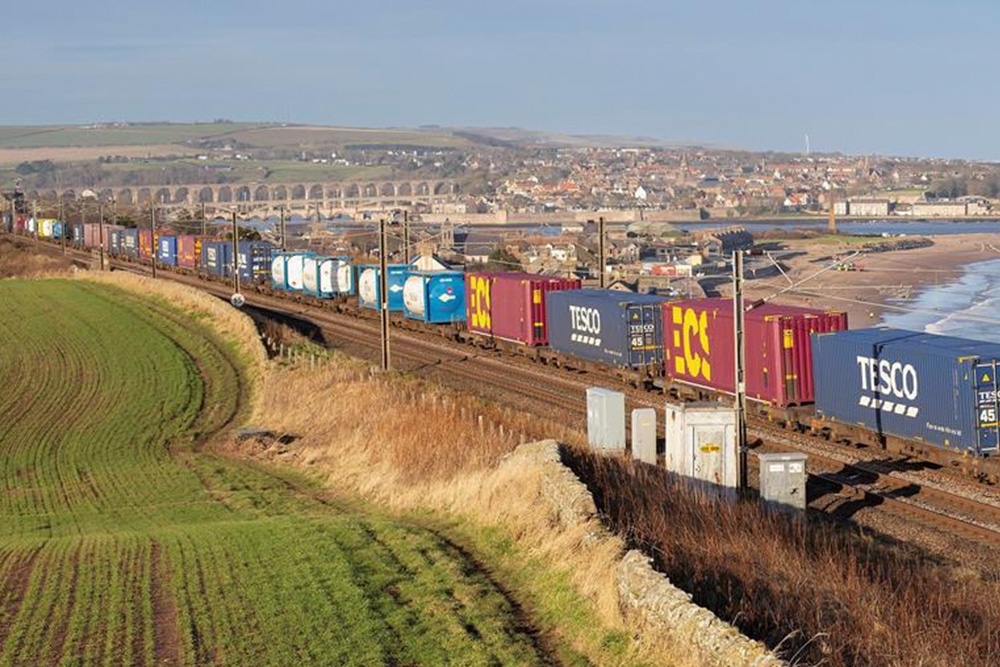At the recent George Bradshaw Address, the Transport Secretary reaffirmed government’s commitment to rail reform, and reassuringly for the rail freight sector, also re-committed to setting a long-term target to grow freight later this year. Rail Partners strongly welcomed this commitment and have published a report showing how significant a contribution to the economy and environment rail freight could make if we make that target an ambitious one. Director of policy John Thomas explains more
Our members have seen first-hand just how transformative a growth target can be. In Scotland, where a target to grow rail freight was set for the current control period (between 2019-2024), operators have worked with Network Rail, Transport Scotland and customers to achieve a shared goal to grow the rail freight market, securing all the economic and environmental benefits that brings. This partnership is exemplified by the new Highland Spring Service, introduced last Autumn, which was the product of a new rail-connected facility, part-funded by the Freight Facilities Grant awarded by the Scottish Government.
Looking ahead, the recent publication of the Scottish Ministers’ High Level Output Specification (HLOS) for the next Control Period, seeks to build on this with a new target to grow rail freight on the Scottish Network by 2029. A multitude of European governments including France, Spain and Germany have also recently set targets to grow rail freight’s modal share significantly by 2030, as they explore ways to decarbonise their supply chains. While direct comparisons are hard to make there is reason to be optimistic that these will also deliver for our European counterparts.
Ever since the publication of the Plan for Rail White Paper, we have called for a stretching target to treble rail freight by 2050. This could appear over-ambitious but Rail Partners believes that with the right supporting policy framework this can be achieved and would deliver substantial economic benefits as well as playing a key role in supporting government to deliver on its legislative commitment to achieve net zero carbon emissions.
Much of the demand exists already. Customers with their own sustainability commitments to deliver are increasingly turning towards rail as a greener, more reliable and cost effective way to get their goods to market. Our report cites case studies from Toyota, who have recently introduced a new international rail freight service shaving four days off transit times to France and the Czech Republic, and Tarmac who are now benefitting from the operation of ‘jumbo’ trains which, as our report demonstrates, are improving the carbon performance of rail freight yet further.
Although wider factors such as ongoing industrial action and the economic downturn have recently flattened the surge in demand and risk damaging future growth, the prevailing tailwinds for rail freight are positive and should be built on by the sector and government.
To underline the size of the prize from trebling rail freight by 2050, Rail Partners commissioned new analysis to assess the environmental performance of rail freight today, and how the sector’s economic and environmental contribution could evolve over the course of the next generation.
Independent analysis by Aether, the University of Hull’s Logistics Institute and Railfreight Consulting shows that, thanks to productivity improvements made by freight operators and customers to run longer, heavier services – a single freight service is now removing up to 129 HGV road journeys. This not only helps to decongest our towns and cities, but longer and heavier freight services significantly enhance rail freight’s carbon and air quality performance. As an example, adding an additional 10 wagons on to a relatively short aggregates train (initially 19 wagons), reduces carbon emitted per tonne by almost 10%.
These productivity improvements have enabled rail to retain its comparative carbon advantage over road – despite recent improvements from the road sector as vehicles become more carbon efficient. Our new analysis demonstrates that, on average, a diesel hauled freight train produces 76% less CO2 than the equivalent by road.
The use of more electric traction, and wider utilisation of low-carbon fuels like Hydrotreated Vegetable Oil (HVO) will drive rail freight’s carbon footprint down further and opportunities to incentivise the early adoption of alternative fuels should be explored.
Should a target of trebling of rail freight be realised, the consultants estimate that the sector will contribute nearly £5.2bn as a minimum in economic benefits annually. And even in a largely decarbonised freight sector for both rail and road, due to rail’s inherent environmental efficiency, resulting from low friction and drag between steel wheels on steel rails, rail will continue to produce three-quarters less CO2 than road per tonne moved and will reduce air quality particulates by 81% in the year 2050.
Overall, a trebling of rail freight is estimated to remove over 20 million HGV movements, reducing journey times for other road users and reducing the depreciation of the road network.
Our analysis also extrapolates market forecasts, based on transport economists MDS Transmodal’s analysis for Network Rail, to show that a trebling of freight can be achieved by 2050 based on likely demand growth. Prevalent markets such as intermodal and construction are expected to grow, as is the metals market which incorporates the movement of steel and iron in support of Britain’s manufacturing industry.
Long-term market forecasts are by their nature an inexact science, but should any of the markets analysed in the report fall short of their expected growth, there is scope for other fledgling markets to fill the gap such as the movement of alternative fuels and high-speed freight.
It is important to stress that a trebling of rail freight does not require a trebling of freight services or an immediate flurry of capital investments from government during the current challenging economic environment. In fact, a large proportion of freight growth can be achieved through increasingly productive freight services and small tweaks in the allocation of existing capacity.
What is clear though, is that delivering freight growth will not be possible without the public and private sectors working in partnership.
Only with clear policy direction set from government, for example in terms of future capacity enhancement schemes and electrification, will a largely private rail freight industry have the confidence to build on its proud track record of investment to grow the market.
To secure the benefits for our economy and environment, our report outlines a policy framework to create the conditions for freight to grow:
· setting an ambitious growth target of trebling freight by 2050;
· maintaining a stable access, charging and performance regime
· making optimal use of existing capacity on the rail network
· targeted infrastructure investments on areas of the network with high rail freight growth potential
· and an expansion of incentives, including the Mode Shift Revenue Support (MSRS) scheme and Freight Facilities Grant (FFG), to make rail the mode of choice for freight customers
Wider rail reform has new-found momentum following the Secretary of State’s address last month – and freight must not be left behind. It is vital that government, Network Rail, the Great British railways Transition Team, and the Freight operating companies come together to begin implementing this policy framework at pace.
Click here to read the full report.

Photo credit: Rail Partners







































 0113 2082620
0113 2082620 info@railbusinessdaily.com
info@railbusinessdaily.com 15 Mariner Court, Wakefield WF4 3FL
15 Mariner Court, Wakefield WF4 3FL

